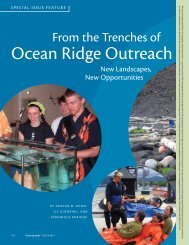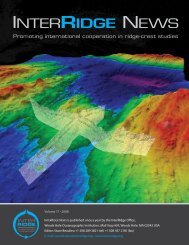Full version, low resolution, 7.5MB - InterRidge
Full version, low resolution, 7.5MB - InterRidge
Full version, low resolution, 7.5MB - InterRidge
You also want an ePaper? Increase the reach of your titles
YUMPU automatically turns print PDFs into web optimized ePapers that Google loves.
International Research<br />
McGuire, J. J., M. S. Boettcher and T. H. Jordan. Foreshock<br />
sequences and short-term earthquake predictability on East Pacific<br />
Rise transform faults. Nature, 434, 457-462, 2005.<br />
Menard, H. W. and T. Atwater. Origin of Fracture Zone<br />
Topography. Nature, 222, 1037-1040, 1969.<br />
Perfit, M. R., D. J. Fornari, W. I. Ridley, P. D. Kirk, J. Casey, K. A.<br />
Kastens, J. R. Reynolds, M. Edwards, D. Desonie, R. Shuster and S.<br />
Paradis. Recent volcanism in the Siqueiros transform fault: picritic<br />
basalts and implications for MORB magma genesis. Earth Planet.<br />
Sci. Lett., 141, 91-108, 1996.<br />
Pockalny, A., P. J. Fox, D. J. Fornari, C. Macdonald and M. R. Perfit.<br />
Tectonic reconstruction of the Clipperton and Siqueiros Fracture<br />
Zones: Evidence and consequences of plate motion change for the<br />
last 3 Myr. J. Geophys. Res., 102, 3167-3181, 1997.<br />
Searle, R. C. Multiple, closely spaced transform faults in fast-slipping<br />
fracture zones. Geology, 11, 607-610, 1983.<br />
Smith, D.K., J. R. Cann and J. Escartin. Widespread active<br />
detachment faulting and core complex formation near 13°N on the<br />
Mid-Atlantic. Nature, 442, 440-443, 2006.<br />
Smith, D. K., J. Escartin, H. Schouten and J. R. Cann. Fault rotation<br />
and core complex formation: Significant processes in seafloor<br />
formation at s<strong>low</strong>-spreading mid-ocean ridges (Mid-Atlantic Ridge,<br />
13-15°N). Geochem. Geophys. Geosys., 9, Q03003, doi:10.1029/<br />
2007GC001699, 2008.<br />
Tucholke, B E, J. Lin and M.C. Kleinrock. Megamullions and<br />
mullion structure defining oceanic metamorphic core complexes on<br />
the Mid-Atlantic Ridge. J. Geophys. Res.,103, 9857-9866, 1998.<br />
Roest, W. R. and B. J. Collette. The Fifteen Twenty Fracture Zone<br />
and the North American-South American plate boundary. J. Geol.<br />
Soc., 143, 833-843, 1986.<br />
A tale of two blocks: New insights on the evolution of the Zambales Ophiolite<br />
Complex, Luzon Island, Philippines<br />
Graciano P. Yumul Jr. 1 , Carla B. Dimalanta 2 , Karlo L. Queaño 3 , Decibel V. Faustino-Eslava 4 Edanjarlo J. Marquez 5 , Noelynna<br />
T. Ramos 2 , Keisuke Ishida 6 , Shigeyuki Suzuki 7 , Ricky C. Salapare 2 , Michael Peter M. Sanchez 8 , Juan Miguel R.<br />
Guotana 8 , Rose Ann B. Concepcion 2<br />
Introduction<br />
For the past decades, our research team has been involved in the<br />
studies of ophiolitic sequences across the Philippine archipelago<br />
(e.g. Yumul et al., 1998; Tamayo et al., 2001; Suerte et al., 2005; Andal<br />
et al., 2005; Faustino et al., 2006; Dimalanta et al., 2009). Recent<br />
investigations have been done to better constrain the emplacement<br />
history of one of the more studied ophiolites in the region, the<br />
Zambales Ophiolite Complex (ZOC). Geological, petrological and<br />
paleontological data presented here provide new insights on the<br />
tectonic evolution of the ophiolite terrane.<br />
Zambales Ophiolite Complex (ZOC)<br />
The ZOC is a complete crust-mantle sequence that occurs as a<br />
north-south trending ridge in western Central Luzon (Figure 1).<br />
Previous works regard this ophiolite to have been formed during<br />
the Eocene on the basis of fossil assemblages observed from the<br />
pelagic Aksitero Formation that overlies the ZOC along the western<br />
foothills of southern Zambales Range (Amato, 1965; Villones, 1980;<br />
Schweller et al., 1983). The Eocene age derived from fossils is<br />
supported by the K-Ar dating of diabase and granodiorite dikes in<br />
Coto Mine that yielded 46.6 (±5.1) Ma to 44 (±3.5) Ma (<strong>Full</strong>er et al.,<br />
1989) and by the U-Pb dating of tonalite (Acoje Block) and<br />
leucocratic tonalite and hornblende quartz diorite (Coto Block) that<br />
yielded 45.1 (±0.6) Ma to 44.2 (±0.9) Ma (Encarnacion et al., 1993),<br />
respectively. Thus, an Eocene age had been adopted for the entire<br />
ZOC.<br />
Two blocks of contrasting petrological and geochemical<br />
characteristics comprise the ZOC: the Acoje and the Coto Blocks.<br />
The Acoje Block exhibits an island arc signature whereas the Coto<br />
Block is of transitional mid-oceanic ridge basalt to island arc<br />
signature. The difference between these two blocks is further<br />
highlighted by the chromite types they host. The Acoje Block<br />
1<br />
Monte Oro Resources and Energy Inc. Makati City, Philippines; 2 National Institute of Geological Sciences, University of the Philippines - Diliman, Quezon<br />
City, Philippines; 3 School of Civil, Environmental, and Geological Engineering, Mapúa Institute of Technology, Intramuros, Manila, Philippines; 4 School of<br />
Environmental Science and Management, University of the Philippines - Los Baños, Laguna, Philippines; 5 Department of Physical Sciences and Mathematics,<br />
University of the Philippines – Manila, Padre Faura, Manila, Philippines; 6 Institute of Socio-Arts and Sciences, University of Tokushima, Japan; 7 Department<br />
of Earth Sciences, Okayama University, Japan; 8 Department of Civil Engineering, Adamson University, Manila, Philippines<br />
INTERRIDGE NEWS 27 VOL.21, 2012
















